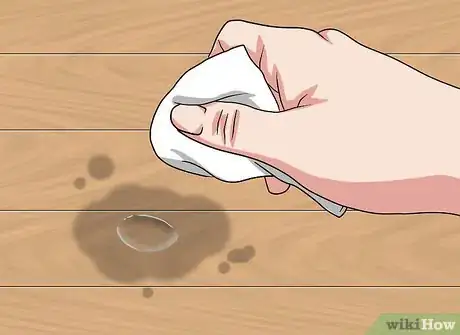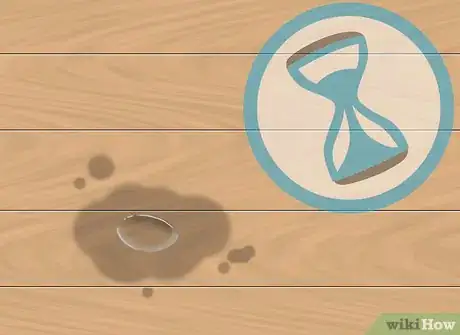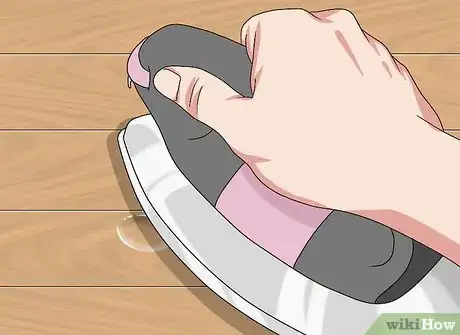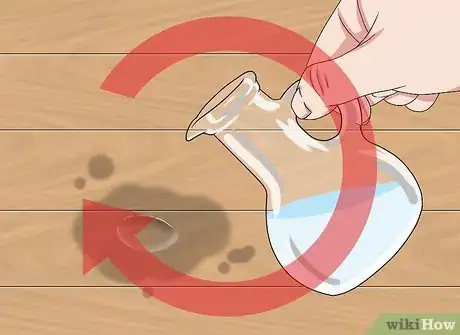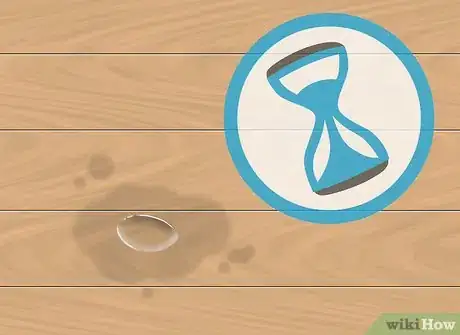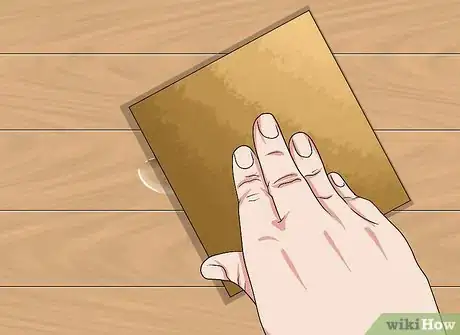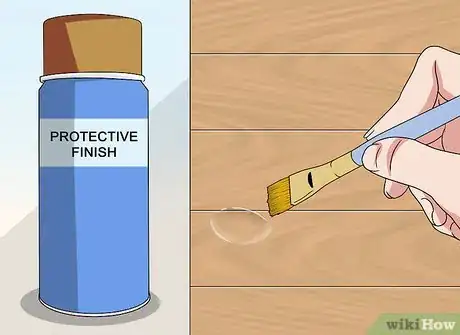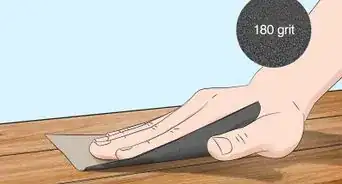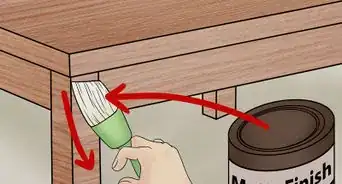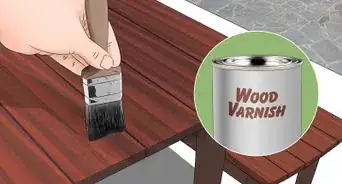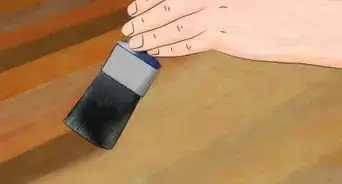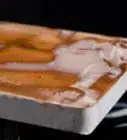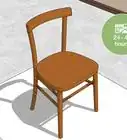This article was co-authored by David Julien. David Julien is a DIY Specialist and the Principal Owner at Nice DIY based in Quebec, Canada. David specializes in creating plans to make unique, affordable, and modern home furnishings. He holds a BA in Graphic Design from the University of Quebec Outaouais. Nice DIY uses sustainable and high-quality materials to create products that are simple to make for everyone.
There are 9 references cited in this article, which can be found at the bottom of the page.
This article has been viewed 144,172 times.
If you’ve noticed an unsightly dent in your wood flooring or furniture, you might fear that it’s ruined for good. But there’s actually a very simple solution for lifting dents from soft wood surfaces—the magic combination of heat and moisture. By running an ordinary clothes iron over the spot, you can erase shallow dents and dings and restore the wood to its original smoothness. This fix takes only a few minutes, and when you’re finished you’ll barely be able to tell that there was ever a flaw in the first place.
Steps
Wetting the Wood
-
1Dab the dent with water. Pour about an ounce of water over the affected area, just enough to cover the dent and a small part of the surrounding wood. Make sure the dent is completely wet. Pooling inside the depression itself is a good sign that the spot has been thoroughly soaked.[1]
- Using an eyedropper or kitchen baster will give you more control over where you apply the water.
- If there’s any serious breakage or chipping around the dent, you may need to have the surface repaired professionally to avoid making it worse.
-
2Place a damp paper towel or piece of cloth over the dent. Wet the cloth or paper towel and wring out the excess water, then lay it directly on top of the dent. This will provide a little added moisture while also creating a buffer that will help protect the wood from being damaged by the heat of the iron.[2]
- It may be a good idea to use an old t-shirt, dusting rag or some other piece of fabric that you don’t care about potentially ruining.
- If the dent is located on the side or corner of a piece of furniture, you might need to hold the cloth in place with your free hand while you steam the wood.[3]
Advertisement -
3Give the water time to soak into the wood. Let the wood sit for a minute or two to absorb as much moisture as possible. As the water seeps into the wood, it will cause it to soften and become pliable. Once you apply heat to the spot, the wood will expand and the dent will lift right out.
- The deeper the water penetrates into the wood, the more effective the steaming process will be.
Steaming Out the Dent
-
1Heat up a clothes iron. Plug the iron in and turn it on to the highest setting. Give it a few minutes to start warming up—it needs to be nice and hot in order to work effectively.[4]
- The iron will be very hot after you’ve turned it on. Touching the surface could result in a painful burn.
- When you’re not using the iron, set it on a hard, level surface where it won’t get tipped over.
-
2Run the iron over the dented area. Press the iron into the damp cloth above the dent and move it around using slow circular motions. Make a few passes, gradually widening the area that you’re ironing. Keep heating the wood until the cloth is dry, then lift a corner to check your progress.[5]
- The heat from the iron (coupled with the moisture of the water) will cause the compressed wood in the dent to swell, returning it to its original form.
- Try not to let the iron sit in one place for too long, or it may scorch the cloth or the wood underneath.[6]
-
3Rewet the wood and repeat as needed. A single ironing might be all you need to deal with minor dents. For more severe depressions or areas with multiple marks, continue adding water and ironing slowly until the worst of the dents have been raised.[7]
- Between attempts, be sure to dampen the cloth with fresh water or grab a fresh paper towel.
- You might not be able to remove deep dents entirely. However, steaming will help to level them out and make them less noticeable.[8]
Finishing and Protecting the Wood
-
1Let the wood dry completely. Wet wood is soft, which makes it prone to splitting and breakage. Allow the surface to air dry before handling it. In the meantime, hold off on replacing furniture or setting other objects on it to avoid further accidents.[9]
- The heat of the iron will have evaporated most of the moisture, but it may take a few hours to regain its full hardness and rigidity.
- The wood will shrink somewhat as it dries, which can cause problems if you begin sanding or putting pressure on it too soon.
-
2Smooth out the wood with sandpaper. In some cases, small flaws may be left behind in the wood, or the water might produce a slight discoloration. You can remedy this by running a square of high-grit sandpaper over the area until it blends in with the wood around it.[10]
- Use light, smooth strokes to avoid scratching the wood surface, which may have been weakened by the dent.
-
3Brush on a protective finish. When you're done buffing imperfections out of finished surfaces, be sure to touch them up with a fresh coat of paint or laminate. This will help conceal any remaining traces of the dent and act as a barrier against knocks and bumps in the future.[11]
- A water-based satin varnish is a great option for a protective finish.
- In most cases, a single coat will do to cover up the spot where the dent was.
- Allow the refinished surface to air dry overnight before touching it.
-
4Repair large dents with a filler material. Steaming won’t always be enough to eliminate dents. Deep gouges and spots with breaking, splitting or chipping should be looked at by a professional. Extensive damage can usually be repaired with a durable epoxy or lacquer filler.[12]
- For bigger jobs, have a woodworker cut a special wood inlay to fit the damaged area.[13]
- Afterwards, the repaired surface will likely need to be resealed or stained.
Expert Q&A
-
QuestionHow do I refinish a piece of furniture after removing the dent?
 David JulienDavid Julien is a DIY Specialist and the Principal Owner at Nice DIY based in Quebec, Canada. David specializes in creating plans to make unique, affordable, and modern home furnishings. He holds a BA in Graphic Design from the University of Quebec Outaouais. Nice DIY uses sustainable and high-quality materials to create products that are simple to make for everyone.
David JulienDavid Julien is a DIY Specialist and the Principal Owner at Nice DIY based in Quebec, Canada. David specializes in creating plans to make unique, affordable, and modern home furnishings. He holds a BA in Graphic Design from the University of Quebec Outaouais. Nice DIY uses sustainable and high-quality materials to create products that are simple to make for everyone.
DIY Specialist Start by preparing the surface. Remove existing paint or varnish using acetone, or any other product for this purpose. Then, sand the surfaces with rough sandpaper until the previous color disappears completely. In order to finish the preparation of your surface, sand with fine-grit sandpaper. Apply your new stain or paint color. To facilitate the weekly cleaning of the furniture, apply a water-based satin varnish.
Start by preparing the surface. Remove existing paint or varnish using acetone, or any other product for this purpose. Then, sand the surfaces with rough sandpaper until the previous color disappears completely. In order to finish the preparation of your surface, sand with fine-grit sandpaper. Apply your new stain or paint color. To facilitate the weekly cleaning of the furniture, apply a water-based satin varnish. -
QuestionI dropped my laptop on my hardwood floors, which left dents and scratches. Since it was a MacBook, some of the wood is the tiniest bit splintered. Will using an iron possibly damage the floor?
 Jack Pierce_26Community AnswerYes, irons can possibly create fire hazards. Instead, use a file, axe, or anything else that will remove chips. Although a file is less efficient, it is less dangerous. You can replace it with a new plank, square, or whatever your floor's wood is made out of, and the shape.
Jack Pierce_26Community AnswerYes, irons can possibly create fire hazards. Instead, use a file, axe, or anything else that will remove chips. Although a file is less efficient, it is less dangerous. You can replace it with a new plank, square, or whatever your floor's wood is made out of, and the shape. -
QuestionMy wood floors have been sanded and satin stained and they pulled out my refrigerator and caused a long line dent on both sides. Can this be fixed?
 DonaganTop AnswererIt's possible that "leveling compound" could be applied, but someone with flooring expertise would have to look at it to be sure.
DonaganTop AnswererIt's possible that "leveling compound" could be applied, but someone with flooring expertise would have to look at it to be sure.
Warnings
- Don’t allow the iron to come into direct contact with the wood surface.⧼thumbs_response⧽
- Avoid using a synthetic fabric to cover the wood. These can easily melt under the heat of the iron.⧼thumbs_response⧽
- There’s no guarantee that steaming will work on hardwood surfaces, or those layered thickly with paint or clear coat.⧼thumbs_response⧽
Things You'll Need
- Clothes iron
- Water
- Thin cloth or paper towel
- High-grit sandpaper
- Eyedropper or baster (optional)
- Lacquer, varnish or acrylic paint (optional)
References
- ↑ http://www.instructables.com/id/How-to-remove-a-dent-from-wood/
- ↑ https://www.builddirect.com/learning-center/flooring/repair-scratch-dent-hardwood-floors/
- ↑ https://www.youtube.com/watch?v=fMEZSDPFzf4
- ↑ http://www.apartmenttherapy.com/how-to-fix-dents-in-wooden-floors-furniture-with-an-iron-166696
- ↑ http://www.instructables.com/id/How-to-remove-a-dent-from-wood/
- ↑ https://www.youtube.com/watch?v=ZsJvrosibuE
- ↑ https://www.hunker.com/12443313/removing-dents-from-finished-wood
- ↑ http://www.apartmenttherapy.com/how-to-fix-dents-in-wooden-floors-furniture-with-an-iron-166696
- ↑ https://www.wagnermeters.com/working-with-wet-or-too-dry-wood-a-sticky-situation/
About This Article
To remove a dent from wood, start by pouring about an ounce of water onto it. Then, place a damp cloth over the dent. Let the water soak in while you heat up a clothes iron to the highest setting. When your iron has heated up, press it to the cloth and move it in slow circles. Once the cloth is dry, check the dent to see if it’s risen. If the dent is still bad, wet the cloth again and repeat the process. After the wood’s dried for a few hours, brush on a protective finish, like paint or laminate, to help protect the wood and cover up the dent. For more tips, including how to repair large dents with filler, read on!

